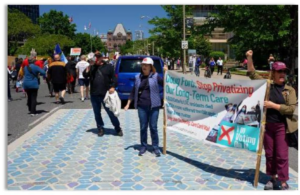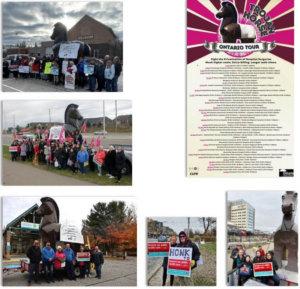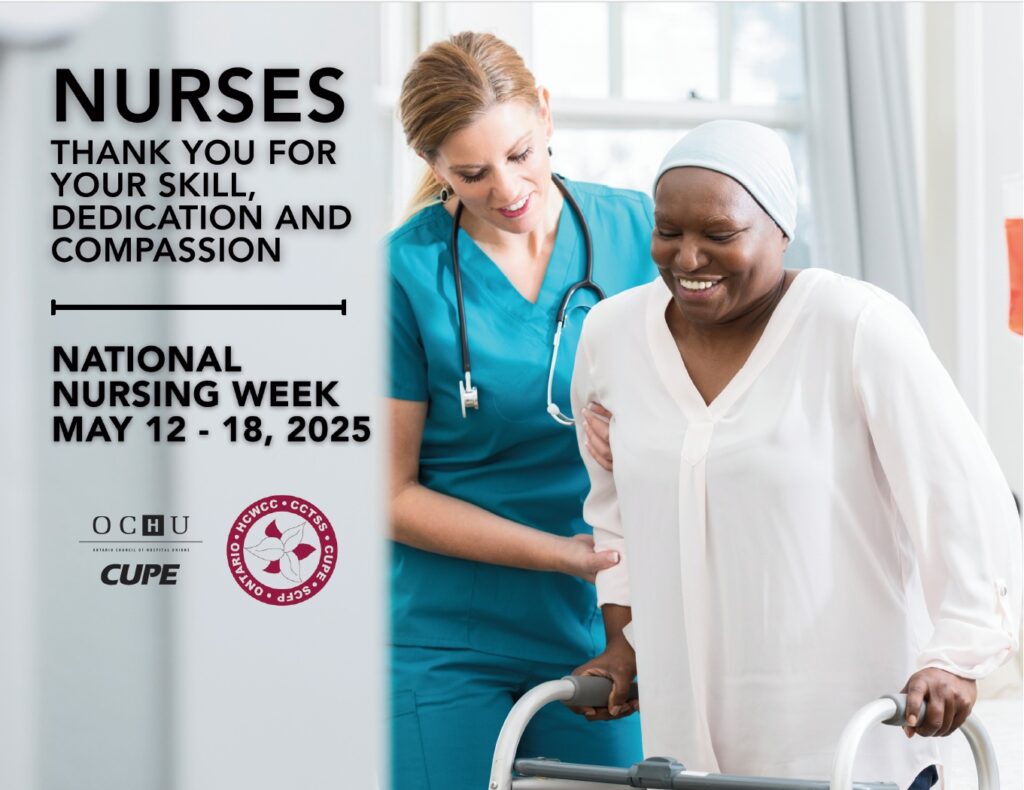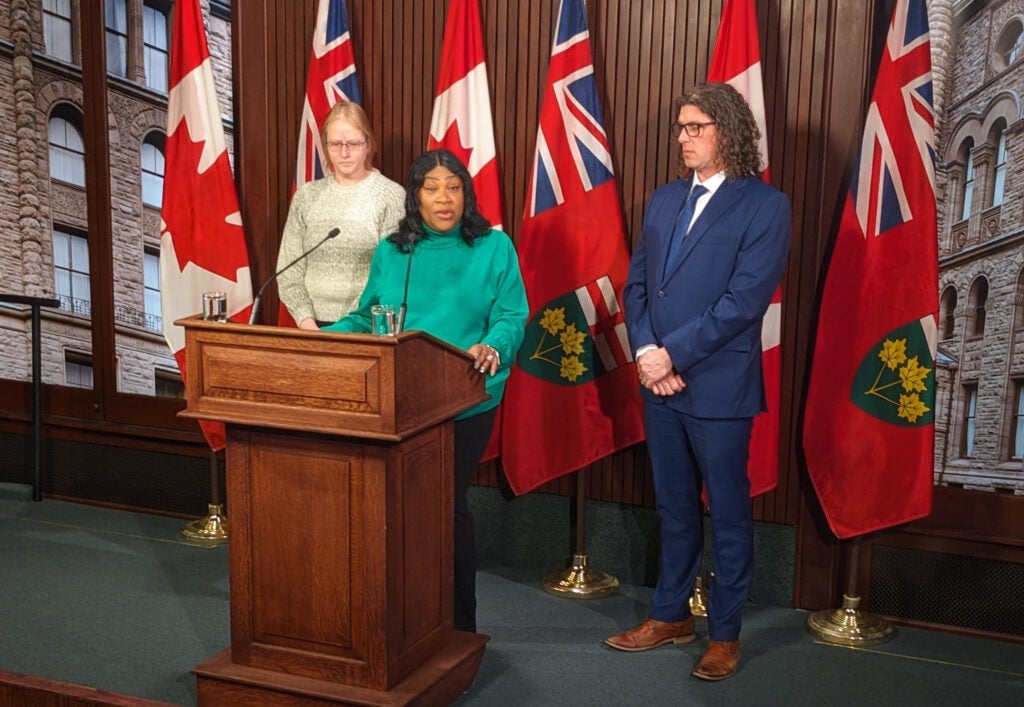The past year was a challenging one for health care in Ontario. Our communities have spent the better part of a hundred years building a public health care system we could be proud of, yet the actions of the Ford government threaten to destroy it. His government has allowed primary care to fall into unprecedented disarray and have expended privatization in virtually all aspects of health care, with patients now paying record breaking user charges in private clinics – exactly what our public medicare laws were written to prevent.
The response to an aggressive attack on all we hold dear is not to be afraid. It is to listen and care about the real needs of people, to raise high– brighter than ever– those ideas and principles that advance equity, compassion and caring for each other that are the real solutions to the crises that our society faces.
Let us also remember and celebrate the incredible job that we do as a Health Coalition, founded to safeguard our public medicare for all. The Coalition is growing massively every year now. Polls show that the opposition to privatization and support for public health care is far higher in Ontario than anywhere else in the country. That is our work. The slight wins we have had in long-term care — some fines for terrible operators, reinstatement of inspections —are due to our relentless efforts together. We still have public hospitals despite Doug Ford’s attempts to privatize them, and the growth in private clinics has not been as robust as his budget plans indicate. That too is our work. We have been featured in literally hundreds of media stories this past year, and we can effectively set the key issues whenever we set out to do so.
We — together — are exceptional. The work we do is vitally important. Thank you from the bottom of my heart, to all of you who have leafletted, protested, organized events, researched, put out social media posts, written letters, attended meetings, donated, and every other thing you do to make our movement one of the most effective and unique in Canada. We could not do it without you.
Please find below our annual report for 2024. We will be sending our action plan for what’s to come for the rest of 2025 in the near future. If you would like to view the annual report as a downloadable/printable PDF, please click here.
Ontario Health Coalition
ANNUAL REPORT 2024

Foreword
Recent events have brought to the forefront the reprehensible cruelty of private health care in the U.S. Whatever one thinks about the shooting of UnitedHealthCare’s CEO, it is undeniable that the American people are furious with the corporations making millions (or billions) from denying care. No wonder. Forbes reported that UnitedHealthCare denies more claims than other health insurance companies in the U.S., rejecting up to one in every three. (The company denies this.) UnitedHealthcare, as part of the giant conglomerate UnitedHealth Group, reportedly made more than $16 billion in operating profits last year.
Medical costs are the number one reason for bankruptcy in the U.S. Fifty-six million people struggle with medical debt each year. That’s more than the entire population of Canada. Ninety percent of them took out a second mortgage and eleven million people last year ran up high interest debt on their credit cards to pay medical bills. They will be stuck in a cycle of debt for years, if not for life.
Juxtapose this against the actions of the Ford government. While Mr. Ford has paraded all over the news in recent weeks as the champion of Canadian sovereignty against the U.S., he has in actuality been pushing for massive increases in defence spending (Donald Trump’s agenda) which will take money away from public services and priorities such as affordable housing. He is also pushing American-style privatization of our public health care services, and for this, it didn’t seem to matter to him that he had no mandate. In fact, quite the opposite.
If I sound angry, it is because I am. Our communities have spent the better part of a hundred years building a public health care system we could be proud of. Canada created our public health insurance for all in the 1960s because people couldn’t afford health care on their own. As Justice Emmett Hall, the chair of Royal Commission on Medical Services that resulted in the 1968 passage of the Medical Care Act said:
“As a society, [we] are aware that the trauma of illness, the pain of surgery, the slow decline to death, are burdens enough for the human being to bear without the added burden of medical or hospital bills penalizing the patient at the moment of vulnerability. The Canadian people determined that they should band together to pay medical bills and hospital bills when they were well and income earning. Health services [are] a fundamental need, like education, which Canadians could meet collectively and pay for through taxes.”
The Canada Health Act, passed in 1984, banned extra billing & user fees for patients for medically needed hospital and physician services. We do not have millions of people going bankrupt to pay medical bills because we have public health insurance – paid by taxes. We do not have profiteering insurance companies denying claims to make billions in profit from the sick and the dying.
Yet the actions of Doug Ford threaten to destroy this. His government has allowed primary care to fall into unprecedented disarray. 2.5 million Ontarians now do not have a family doctor, up by a million since Ford took office. He has made policy choices that cannot be described as anything other than deliberate to drive down health care workers’ wages in public and non-profit health services in the midst of a pandemic. His government didn’t provide adequate infection control and socked away billions in unused contingency funds while worsening the health care staffing shortage. He has made budget choices that have forced the majority of Ontario’s public hospitals into deficit – while in the midst of this crisis – resulting in thousands more people waiting on stretchers, record-breaking emergency department closures, and the loss of entire hospitals and vital services that have been in existence since the 1950s or earlier.
While Ontario’s public hospitals and public health care system are now funded at the lowest rate per person in Canada, his government has almost tripled funding to private for-profit hospitals & clinics. They are expanding privatization in virtually all aspects of health care: primary care, hospitals, long-term care, home care, Public Health, virtual care, mental health and addictions and potentially EMS.
Patients are now paying record breaking user charges in Mr. Ford’s private clinics. We are hearing from people in their 80s and 90s who are being charged $2,000, $4,000, even $8,000 or $10,000 for eye surgeries. These prices are both illegal and ludicrous. We heard from a gentleman in his 70s, forced to go back to work to pay for his cataract surgery and a retiree who was charged $2,000 to get an MRI before her open-heart surgery. These things should never happen in Canada. They are exactly what our public medicare laws were written to prevent.
No one can pretend what Ford has set in motion here isn’t U.S. style health care privatization.
As we head into this year with possible elections provincially and nationally, we are seeing an emboldened set of forces pushing an agenda of militarism and fanning the flames of xenophobia, discrimination and hate while posing as the standard-bearers for the interests of regular people. The response to an aggressive attack on all we hold dear is not to be afraid. It is to listen and care about the real needs of people, to raise high– brighter than ever– those ideas and principles that advance equity, compassion and caring for each other that are the real solutions to the crises that our society faces.
Let us also remember and celebrate the incredible job that we do as a Health Coalition, founded to safeguard our public medicare for all. The Coalition is growing massively every year now. Polls show that the opposition to privatization and support for public health care is far higher in Ontario than anywhere else in the country. That is our work. The slight wins we have had in long-term care — some fines for terrible operators, reinstatement of inspections —are due to our relentless efforts together. We still have public hospitals despite Doug Ford’s attempts to privatize them, and the growth in private clinics has not been as robust as his budget plans indicate. That too is our work. We have been featured in literally hundreds of media stories this year, and we can effectively set the key issues whenever we set out to do so.
We — together — are exceptional. The work we do is vitally important. Thank you from the bottom of my heart, to all of you who have leafletted, protested, organized events, researched, put out social media posts, written letters, attended meetings, donated, and every other thing you do to make our movement one of the most effective and unique in Canada. We could not do it without you.
Natalie Mehra
Executive Director
May 30 Day of Protest against Ford’s privatization & destruction of our public health care
On May 30, the Ontario Health Coalition held a huge protest and march in Toronto, and additional protests in Sault Ste Marie, Thunder Bay, Cornwall, Ottawa, North Bay and Dryden against the Ford government’s privatization and destruction of our public health care. Almost 10,000 people came out to Queen’s Park for the march and rally. Approximately 700 more joined in North Bay, Sault Ste Marie, Thunder Bay, Dryden, Ottawa and Cornwall.
We received significant media coverage from all the major news outlets across the province, including Global TV, CTV, CBC, CP24 as well and newspaper and radio coverage. The march in Toronto was massive, taking up University Avenue for more than an entire city block.
The protests made visible the opposition to privatization and raised the profile of the issues. By late spring, polling showed that the majority of Ontarians believe that the Ford government is purposely driving down our public health care to privatize it.

Mass Leaflet & Website
This year we undertook a massive public education campaign. We distributed almost a million leaflets across Ontario door-to-door, in workplaces and at community tables, in markets and community groups. Thousands of volunteers helped to get out the word. We also purchased the URL www.StopForProfitHealthcare.ca and set up a dedicated campaign website with information and tracking. Volunteers tracked the distribution of more than a quarter of a million leaflets on the website map. The effort was amazing! In some parts of Ontario, entire towns were covered door-to-door. The mass outreach and education campaign has been very effective. While all across Canada the majority oppose health care privatization, polling is showing significantly higher support for public health care and opposition to privatization in Ontario compared to other provinces.

Lawn Signs
Working with volunteers in local coalitions, we put up more than 5,000 signs on people’s lawns across Ontario opposing the Ford government’s privatization of our public health care.

Legal Challenges
Fighting for-profit long-term care: Orchard Villa Legal Challenge
The Ontario government reported that it has issued an undertaking to Southbridge to proceed with the 87-bed expansion of Orchard Villa, which would open under a new license of up to 30 years. Southbridge, which owns Orchard Villa, is a for-profit corporation that had the worst record for deaths in its long-term care homes in Ontario during the pandemic. More than 70 residents in Orchard Villa died of COVID alone. The military was sent into the home and found residents on bare mattresses without linens, mattresses put on the floor so residents couldn’t get up and walk, improper feeding that resulted in a resident choking to death, piled up trays with decaying food, and much more. Under Ontario law, the Ministry of Long-Term Care is barred from giving licenses to corporations with terrible records of neglect and inadequate care. We filed a Notice of Application to the court for an order quashing the license and went to court to stop the massive expansion and new 30-year license. We held multiple press conferences with the families of residents and the court hearing was held in October. There has been significant media coverage of this initiative. We fundraised to cover the extraordinary cost of the court challenge and are awaiting the court’s ruling.
Fighting for equality and consent rights for elderly patients: Bill 7 Charter Challenge
In response to a new law passed by the Ford government enabling elderly patients to be forced into long-term care homes not of their choosing up to 70 km away in Southern Ontario and up to 150 km away in Northern Ontario, the Ontario Health Coalition brought a legal challenge under the Bill of Rights in our Constitution. The law violates the constitutional rights of the elderly to equal treatment, violates their right to informed consent and violates their right to life, liberty and security of the person. We held multiple press conferences and issued media releases about the case, and there has been considerable media coverage of this issue. In September, our lawyers argued the Charter Challenge on Bill 7 before the Ontario Divisional Court. We continue to fundraise to cover the extraordinary costs for this initiative.

Small, Rural & Local Hospitals Hearings
In June, we held nine cross-province hearings and received numerous verbal and 138 written submissions depicting the state of local hospitals and the challenges faced by reduced local hospital capacity. Travelling with to hear the testimony of Ontarians was a panel of experts including OHC executive director Natalie Mehra; Graham Webb, lawyer and executive director of the Advocacy Centre for the Elderly; Michael Hurley, President of the Ontario Council of Hospital Unions; France Gélinas, NDP Health Critic; Dr. Adil Shamji, Liberal Health Critic and Mike Schreiner, Leader of the Green Party. The response from participants and panelists were overwhelmingly positive. In October, we held a rescheduled hearing in Blind River and accepted final verbal and written submissions to incorporate into a final report and recommendations to be released across the province.

Robbing the public to build the private:
The Ford government’s hospital privatization scheme
Over the course of the last year, the Coalition researched the unused capacity in local public hospitals through Freedom of Information requests and interviews with surgical staff. Across the province, we gathered information about local hospital operating rooms that are closed in evenings, on weekends, or even permanently due to underfunding. At the same time, we gathered figures from Ontario government budget and expense documents, media reports, contracts and accountability agreements to provide a litany of examples of much higher costs and large funding increases provided by the Ford government to for-profit corporation clinics, hospitals and staffing agencies. Meanwhile, the government has imposed real dollar cuts, deficits, and wage caps on public hospitals, robbing them of the ability to attract and retain staff and use their existing operating room capacity. On Wednesday February 21 we held press conferences across the province and in Toronto to release the report.

Illegal and Unlawful Extra-billing of Patients in Private Clinics
In April, we released a second new research report Illegal, Unlawful and Unethical: Case Studies of Patients Charged for Medical Care in Ontario’s Private Clinics, featured evidence from more than a hundred patients about user fees being charged in Ontario’s private clinics. The Health Coalition held press conferences to release the report with patients who have been charged hundreds or even thousands of dollars for access to care by these for-profit clinics. Most of the patients are seniors on fixed incomes who were charged up to $8,000 or more for eye surgeries and tests, we found. The fees impose significant financial strain, forcing one patient to go back to work at the age of 71 to pay the bill, and others to fall into debt, use up all their savings, borrow money or go without other needs.

Fact Sheets & Myth Busters
We have produced a number of reports, facts sheets and myth busters and distributed them widely to provide our members and supporters with the information they need to cut through the false claims of the Ford government, including:
• An updated briefing note on the Ford government’s hospital privatization plan
• A fact sheet on the top ten myths about health care privatization
• A fact checker and briefing note on Ford’s health care funding
• Facts re. OHIP coverage for cataract surgery
• Briefing note on the history of public medicare in Canada
• Briefing note and key facts on health care funding
Public Education & Outreach
We have been extremely active educating the public and our members about public health care, privatization, patient rights and the key issues. Our webinars have been attended by more than 1,500 people this year. Our email briefing notes reach more than 100,000 people and our social media reaches up to 300,000 people per month. Our websites also are well used, with 10,000- 20,000 views per month.
History of Public Medicare in Canada
Working with our nursing student interns from Toronto Metropolitan University, we released social media videos, a briefing note and a fact sheet about the history of Public Medicare in Canada. We gave a briefing and featured this information in a webinar attended by more than 200 people.
Long-term care virtual townhall
Working with Will Davidson LLP, we held a virtual townhall to brief people and answer questions about the lawsuits against the long-term care homes for negligence during COVID. The session was well attended with more than 300 people participating. A summary and follow-up information were distributed to participants and posted on our website.
Mass Public Outreach Campaign Briefing & Training Sessions
We held two sessions in March to help educate our members about the mass outreach campaign. More than 360 people attended. Ontario Health Coalition executive director Natalie Mehra briefed participants on the imminent privatization threat, our public education and outreach campaign and held a brief Q&A session.
What OHIP does and does not cover
Under the Skin: How private clinics are embedding illegal user fees into our public health care
This webinar on what OHIP covers and does not cover, and how private clinics are charging patients illegal user fees for care was attended by almost 200 people. We produced a fact sheet, slide show and video and distributed these resources widely. Executive Director Natalie Mehra gave a slide presentation. A lively question and answer period followed with many participants giving examples of the extra-billing and user fees.
Hospital Discharges: the rights of patients and their substitute decision-makers
We held an educational webinar in November on hospital discharges and our executive director Natalie Mehra answered questions with the Advocacy Centre for the Elderly’s Jane Meadus. The webinar was attended by more than 130 people. Follow up materials, including facts and information have been distributed widely.
Zoom Summits on the Ford government’s health care privatization & the fight back
We held 2 Zoom “Summits” in September to regroup with our members and re-focus on our upcoming efforts by briefing our members and supporters, providing an update on what the Ford government is doing with health care in Ontario, and inspiring an organizing drive to get people involved in the next phase of our campaign to fight against privatization. Cumulatively, more than 400 people joined the sessions.
Exposés on private clinics
Working with Ross Sutherland (Kingston Health Coalition) and Kevin Skerrett (Ottawa Health Coalition) we released two new reports about hospital surgery privatization in Kingston and the South Keys private clinic in Ottawa. The reports are excellent and paint a disturbing picture about extraordinary costs, lack of oversight, two-tier health care, safety and quality issues and other problems in these private for-profit clinics.
Kingston Private Clinic Report
We provided support to the Kingston Health Coalition in the release of their new report on the contract between the Kingston hospitals and a for-profit clinic to rent operating rooms and nurses for private cataract surgeries. Ross Sutherland did an amazing job of research, applying for the release of contracts and information through Freedom of Information requests and scrutinizing hundreds of pages of contracts to find that the privatization costs 56% more than if the surgeries were done by the public hospital. He found a slew of contract irregularities. The report garnered a significant amount of local media coverage.
Ottawa Private Clinics Report
We partnered with the Ottawa Health Coalition to release a report about a private clinic that is selling access to primary care (nurse practitioners) for $400 annual fee plus $75 for the first 45 minutes, other costs thereafter, $150 for mental health assessment and a whole slew of other fees. Aside from our serious concerns about the violations of the Canada Health Act and the Commitment to the Future of Medicare Act, this clinic also raises serious issues about the privatization of the ownership of health care services. The clinic is owned by a businessman, not a clinician, who has been convicted of 64 counts of insurance fraud. His partner in another clinic, also not a clinician, was convicted of sexual assault in that clinic where he posed as a health professional.
NP-Led Clinics and Violations of the Canada Health Act
Ontario Health Coalition executive director Natalie Mehra has done many media interviews this year on Nurse Practitioner clinics charging patients out-of-pocket for access to health care. We met with partner organizations and opposition parties’ Health Critics to ensure that we have a common position clarifying that these charges are violations of the Canada Health Act. We issued press releases and supported Private Members’ Bills to stop the charging of patients for primary care and the privatization of these services.

Local Fight Backs
Fighting the closure of the South Niagara hospitals
Having already lost their emergency departments and inpatient acute care services, the provincial government moved forward with the closure of the hospital urgent care centres in Fort Erie and Port Colborne in evenings and weekend – and they are ultimately planning the closure of the hospitals. The Welland Hospital is also at risk of losing its acute inpatient care. With the Niagara Health Coalition and Fort Erie Healthcare SOS, we have done everything possible to stop the closures, organizing leaflets, attending a huge public meeting in Fort Erie to build the fightback, meeting with MPPs and the hospital, organizing protests and press conferences. Local NDP MPPs Wayne Gates and Jeff Burch brought the issues to the Legislature, distributed petitions, held press conferences and supported the tireless work of the Niagara Health Coalition. More is yet to come.
Durham Hospital Press Conference
Together with the West Grey Mayor and local community members, we have been working to fight against the closure of the inpatient beds at the Durham Hospital. We organized a press conference in May. Joining Ontario Health Coalition executive director Natalie Mehra was Kevin Eccles, Mayor of West Grey; Erin Ariss, President of the Ontario Nurses’ Association; JP Hornick, President of OPSEU and Liberal Health Critic Dr. Adil Shamji. The group spoke with the media at Queen’s Park to demand the Ford government declare a moratorium to save the Durham hospital.
Northwest Ontario Hospital Crisis
We organized a press conference with the Mayor of Rainy River, the President of the District’s paramedics’ and hospital workers’ union and the Thunder Bay Health Coalition on the unprecedented crisis in hospital, EMS, and primary care services in northwestern Ontario. All the physicians in Rainy River resigned, leaving the primary care clinic and hospital without physician coverage and the ambulance base in Emo was threatened with impending closure. As a result of the public pressure, locums were found to provide coverage and the provincial government announce new initiatives to improve the supply of physicians in the North.
Trojan Horse Tour
In partnership with OCHU/CUPE, we joined a huge 57-town tour with a 15-foot tall Trojan Horse of privatization. At each stop, there was a mini-rally of hospital workers and health coalition members with speeches and media materials outlining how health care privatization is like a Trojan Horse posing as a gift but hiding within it the destruction of our public health care. Events were well-attended in many towns. Local media reported about the issues, and took video and photos. The participation across Ontario was amazing! Thank you to all who came out.

Local Health Coalitions
The Health Coalition has grown enormously again this year, and along with new individual members, we continued to develop our capacity in local health coalitions. Including thousands of volunteers, the local health coalitions have been extremely active. From Rainy River to Almonte, Oxford County to Grey Bruce, volunteers covered their communities with lawn signs and leaflets, organized buses to attend protests, fought back against local hospital closures, held hearings, released reports, held press conferences and much more.
These dedicated volunteers are the backbone of the Health Coalition. We are deeply grateful for their commitment and tireless work.

Chinese Canadian Health Coalition
Last year, we committed to make measurable progress in working with diverse communities around health care issues. This year we built on those initial efforts. In addition to popular tables at community events, we held 4 in-person discussion meetings with people from the Chinese community in different regions of the GTA, with more than 100 people attending to discuss what is happening with the dismantling of public health care and the concerning rise in privatization. We also held a large Zoom townhall attended by 97 people from the Chinese community in May. We translated our fact sheets and leaflets into Chinese and held multilingual Zoom briefings including significant participation from the Chinese community. A large contingent attended the May protest in Toronto and activism and we are very encouraged to see the growth in activism and interest.

Thank you to the health care unions & labour movement
For almost a century, unions in Ontario have stood alongside farmers, faith communities, veterans and the broader community to fight for public medicare for all. They continue to educate, organize and fightback to safeguard our public health care from cuts and privatization. We are grateful for their principled stand on behalf of all working people. Thank you for being there, always, in solidarity and support.
















